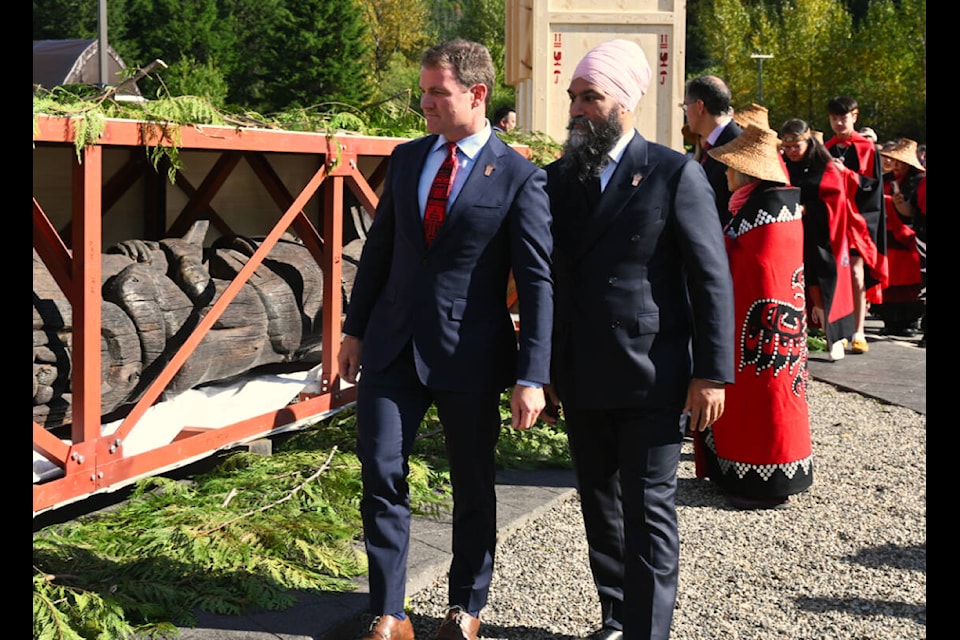After 94 years in Scotland, a Nisga’a Totem Pole finally returned home in spectacular fashion on Sept. 29.
The pole was stolen while the Nisga’a were away during their hunting season, eventually reaching the National Museum of Scotland, where it stayed until earlier this month.
Flown by the Canadian Armed Forces from Trenton, Ontario to Terrace, the pole’s homecoming was celebrated at the national Nisga’a museum in Laxgalts’ap in the Nass Valley.
First carved in the 1860s, the pole was commissioned by a matriarch to honour her nephew, a fallen soldier whose name is carved in the pole. The matriarch was Sim’oogit Ni’isjoohl, Chief Earl Stephens’ great-grandmother, bringing an immense sense of pride to Stephens as the pole was re-matriated.
“It is our ancestor, our great-grandmother. We had to get her back on our home soil,” he said. “In Nisg̱a’a culture, we believe that this pole is alive with the spirit of our ancestors. After nearly 100 years, we are finally able to bring our dear relative home to rest on Nisga’a lands.”
Dignitaries from the provincial and federal governments appeared, including Premier David Eby and Daniel Quan-Watson, federal deputy minister for Crown-Indigenous Relations as well as federal NDP leader Jagmeet Singh.
The return of the Nisga’a pole is a perfect example of reconciliation in action, according to Eva Clayton, president of Nisg̱a’a Lisims Government.
“Today was an incredible journey, that alone represents Truth and Reconciliation to me,” she said. “It marks the beginning of true reconciliation when it comes to bringing our ancestors home, bringing home our artifacts that were taken without consent.”
The ceremony was also an important step forward to meaningful reconciliation for Eby
“Words… are an important aspect of reconciliation,” he said. “But actions bring people together, like today.”
The Nisga’a are a matriarchal society, so the return was an act of re-matration, not repatriation, according to Sigidimnak’ Noxs Ts’aawit Amy Parent.
“It seemed ill-fitting to call this a repatriation,” she said.
A Nisga’a delegation first arrived in Scotland to have their pole returned 20 years ago, though they were rebuffed swiftly. While the years-long negotiations with the Scottish National Museum were not always smooth, Parent said the process was a learning experience for both sides.
“There is always going to be a clash when engaging with settler-colonialist institutions and their worldview,” she said. “It’s never the policy itself, it’s the people behind the policies. And when you begin to make those relationships with people and when you talk about reconciliation, it’s really about moving those people and their hearts more than their minds to do the right thing.
“When we first saw the pole, we could feel it.”
As a worldwide conversation around museums and the return of items acquired by colonial powers to their original owners continues, Parent said this is a win for Indigenous peoples around the world.
“Every time we have success like this it’s a collective win,” she said. “We hope that it is also inspiring and giving colonial institutions further support in terms of doing the right thing in terms of supporting rematriation and repatriation processes.”
The process was an example of “open, honest and productive” dialogue, according to John Divine, head of the Scottish Government Office in Canada.
Nisga’a leaders agreed that the pole’s return will provide a perfect educational template for youth in the community, who will “remember this day forever.”
The pole is not the only stolen item the community is hoping to see come home. Parent said there are Nisga’a cultural items in Canadian, French, German and British Museums that they will be seeking in the future.
“The Nisga’a are coming.”
Video to come.
READ MORE: Nisga’a pole return marks global landmark in reconciliation reckoning
